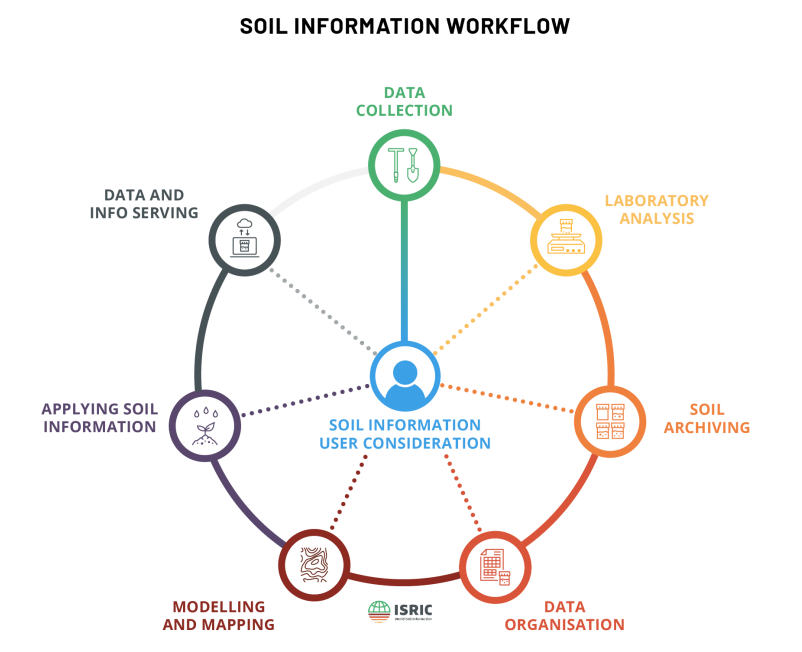Soil Information Workflow
A Soil Information System (SIS) is defined as an integrated information system that facilitates the storage, analysis, management and dissemination of soil data and information. The system often aims to provide users with access to a wide range of soil-related data and information, including soil properties, classifications, maps, and associated environmental data. It may contain multiple data sets, models, and tools in support of improved decision making by end-users. This definition primarily refers to the technological aspects.
There is not one single way to design a SIS because the SIS profile of a country tends to vary depending on end-user needs, data availability, and technical skills. A SIS profile is, therefore, essential to design a sustainable system that links to the use cases and provides a viable business model. The steps of designing and building a SIS can be described in a Soil Data workflow.
A workflow is defined as a ‘sequence of processes through which a piece of work passes from initiation to completion’. The workflow concept can also be applied in the context of soil data: a ‘soil information workflow’. These are several steps that convert soil data into actionable information.
Soil information workflows can vary widely depending on the user needs and specific circumstances in which the workflows are set up and need to function. An initial step in this process is to relate the user’s needs to specific soil information workflow components. This report considers seven components: 1) needs assessment, 2) data collection, 3) laboratory analysis, 4) soil archiving, 5) data organization, 6) modelling and mapping primary soil data (soil properties/types), 7) applying soil information, and 8) data and information serving, as shown in the workflow figure.
The optimal choices of a SIS in methods, tools, standards and implementation options for each step of the soil information workflow are determined by the use cases.

Consult the guidelines on usage of the workflow imagery.
Once the use case(s) and the aim of the Soil Information Systems (SIS) are defined by all stakeholders, including data providers, funders and users, the development of the SIS starts with the collection of soil data. This can entail getting access to …
The user considerations on soil information are essential when setting up a Soil Information System (SIS). The user considerations or needs can contribute to strategic, technical, operational, and institutional requirements for a SIS. If the (end) …
After the collection of soil data and samples, the development of the SIS continues with laboratory analysis on the soil samples. Soil samples collected during field surveys or monitoring programs need to be analyzed in a consistent way to permit …
The standard practice of description of soil profiles and sampling of soils is done based on soil augerings or in soil pits. Physical soil samples may be taken for analysis in the laboratory which yields data for interpretation and storage in …
The data organization step manages the aspect of the adoption of field observation data, lab data, analyzed data and metadata into a central system. It prevents data loss, assesses the quality and harmonization of the data and preparation of the data …
Once soil data is collected, analyzed, archived, and organized, the soil data can be used for modelling and mapping in the next step of the development of a SIS. Soil databases typically contain observations and measurements taken at sampling (point) …
After soil modelling and mapping, is the application of soil information the next step in the development of the SIS. Soil information is applied at different scale levels: from field to continental and even global. In general, soil information is …
The last step of the development of a SIS is serving the data and information present in the SIS in an online environment to make it accessible for users. Data and information serving is the process of making soil data available within the …